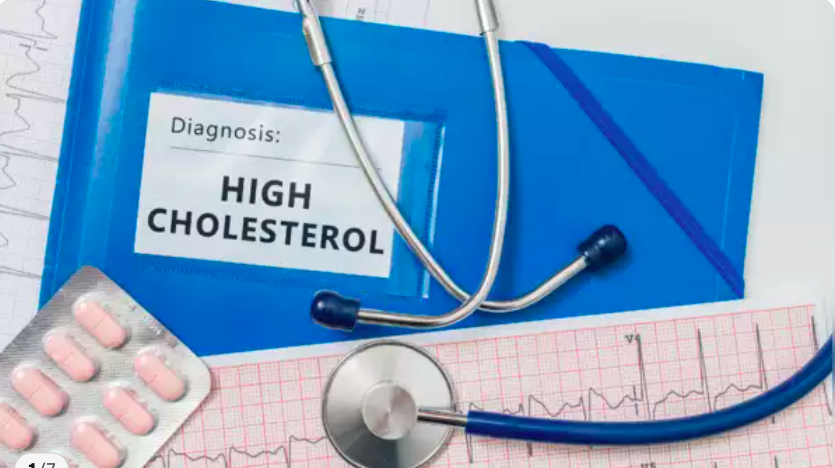Health
How to Prevent a Heart Attack: A Comprehensive Guide

How to Prevent a Heart Attack: A Comprehensive Guide
Introduction Heart disease is the leading cause of death globally. Preventing a heart attack is crucial to living a long and healthy life. In this article, we will provide you with comprehensive information on how to prevent a heart attack. What is a Heart Attack? A heart attack occurs when the blood supply to the heart is blocked.
This blockage is usually caused by a buildup of plaque in the arteries, which restricts blood flow to the heart. Without sufficient blood flow, the heart muscle becomes damaged, and if not treated promptly, can lead to permanent damage or even death.
Risk Factors for Heart Attack Several risk factors increase the likelihood of having a heart attack.
These risk factors include:
- High blood pressure
- High cholesterol
- Diabetes
- Obesity
- Smoking
- Family history of heart disease
- Sedentary lifestyle
- Stress and anxiety
- Age
Preventing a Heart Attack There are several steps you can take to reduce your risk of having a heart attack:
- Quit smoking: Smoking is one of the most significant risk factors for heart disease. If you smoke, quit immediately to reduce your risk of a heart attack.
- Maintain a healthy weight: Being overweight or obese puts additional strain on your heart and increases the risk of heart disease.
- Exercise regularly: Regular physical activity helps maintain a healthy weight, lowers blood pressure, and improves cholesterol levels.
- Eat a healthy diet: A heart-healthy diet includes whole grains, fruits, vegetables, lean proteins, and healthy fats.
- Manage stress: Chronic stress can contribute to heart disease, so it’s important to learn how to manage stress through relaxation techniques, such as yoga or meditation.
- Control your blood pressure: High blood pressure puts added strain on your heart, which can lead to heart disease and heart attacks.
- Control your cholesterol levels: High cholesterol can cause plaque buildup in the arteries, increasing the risk of a heart attack.
- Manage diabetes: High blood sugar levels can damage blood vessels and increase the risk of heart disease.
- Limit alcohol intake: Drinking too much alcohol can raise blood pressure and contribute to obesity, increasing the risk of heart disease.
- Take medication as prescribed: If you have high blood pressure, high cholesterol, or diabetes, take your medication as prescribed to reduce the risk of heart disease.
Symptoms of a Heart Attack Knowing the symptoms of a heart attack can help you act quickly and seek medical attention.
Common symptoms include:
- Chest pain or discomfort
- Shortness of breath
- Nausea or vomiting
- Sweating
- Lightheadedness or dizziness
- Pain in the arms, neck, jaw, back, or stomach
If you experience any of these symptoms, call emergency services immediately.
FAQs
Can a heart attack be prevented?
Yes, a heart attack can be prevented by making lifestyle changes such as quitting smoking, maintaining a healthy weight, exercising regularly, eating a heart-healthy diet, managing stress, and controlling blood pressure, cholesterol, and diabetes.
How can I reduce my risk of heart disease?
You can reduce your risk of heart disease by following a heart-healthy lifestyle, including eating a healthy diet, exercising regularly, not smoking, managing stress, and controlling blood pressure, cholesterol, and diabetes.
What is the difference between a heart attack and a stroke?
A heart attack occurs when the blood supply to the heart is blocked, while a stroke occurs when the blood supply to the brain is blocked. Both conditions require immediate medical attention.
Can stress cause a heart attack?
Chronic stress can contribute to heart disease, increasing the risk of a heart attack.
Can a heart attack happen to anyone?
Yes, a heart attack can happen to anyone, regardless of age or gender. However, certain risk factors increase the likelihood of having a heart attack.
How is a heart attack diagnosed?
A heart attack, also known as a myocardial infarction, is a serious medical condition that requires prompt diagnosis and treatment. There are several ways in which a heart attack can be diagnosed, including:
- Medical history and physical examination: A doctor may ask questions about your symptoms, medical history, and family history of heart disease. They will also perform a physical exam to check for signs of a heart attack, such as an abnormal heartbeat, chest pain, or shortness of breath.
- Electrocardiogram (ECG): This test records the electrical activity of your heart and can detect abnormalities that may indicate a heart attack. The ECG is often the first test performed when someone is suspected of having a heart attack.
- Blood tests: A blood test can measure levels of certain enzymes and proteins that are released into the bloodstream when the heart muscle is damaged. These include troponin and creatine kinase.
- Imaging tests: Imaging tests such as a chest X-ray, echocardiogram, or cardiac CT scan may be used to examine the heart and blood vessels and to detect any blockages or other abnormalities.
- Cardiac catheterization: This is an invasive procedure that involves inserting a thin, flexible tube (catheter) through a blood vessel in the arm or groin and threading it up to the heart. Contrast dye is injected into the arteries to make them visible on X-ray, allowing doctors to see any blockages.
- Stress tests: These tests are used to evaluate how well the heart is functioning during physical activity. They may involve exercising on a treadmill or bike while hooked up to an ECG or other monitoring equipment.
The specific tests used to diagnose a heart attack will depend on the individual’s symptoms and medical history. If you experience chest pain or other symptoms of a heart attack, it is important to seek immediate medical attention.
A heart attack occurs when blood flow to the heart is blocked, leading to damage or death of heart muscle tissue. Treatment for a heart attack involves restoring blood flow to the affected area of the heart as quickly as possible to minimize damage and prevent further complications.
The main treatments for a heart attack include:
- Medications: Medications such as aspirin, nitroglycerin, and antiplatelet drugs like clopidogrel are given to help improve blood flow and reduce the risk of blood clots.
- Oxygen therapy: Supplemental oxygen may be given to improve oxygen levels in the blood and reduce strain on the heart.
- Angioplasty: A minimally invasive procedure that involves threading a catheter through a blood vessel to the site of the blockage and using a balloon to open up the artery. Often a stent (a small metal mesh tube) is inserted into the artery to keep it open.
- Coronary artery bypass grafting (CABG): A surgical procedure that involves taking a healthy blood vessel from another part of the body and using it to bypass the blocked artery.
- Cardiac rehabilitation: After initial treatment, cardiac rehabilitation programs help people recover and return to normal activities. This may include supervised exercise, nutritional counseling, and emotional support.
The choice of treatment depends on the individual’s condition and the severity of the heart attack. In some cases, a combination of treatments may be used to restore blood flow and improve heart function. It is important to seek immediate medical attention if you suspect you or someone you know is experiencing a heart attack.
Yes, a heart attack can be fatal. A heart attack occurs when blood flow to the heart is blocked, leading to damage or death of heart muscle tissue. The severity of a heart attack depends on various factors, including the extent of the blockage, the amount of time that passes before treatment is received, and the overall health of the individual.
If a heart attack is not treated promptly, the damage to the heart muscle can be severe, and the heart may not be able to pump effectively. In some cases, this can lead to heart failure, where the heart is unable to meet the body’s demands for blood and oxygen. A heart attack can also trigger dangerous heart rhythms, such as ventricular fibrillation, which can cause sudden cardiac arrest.
While modern treatments for heart attacks have greatly improved outcomes, a heart attack can still be fatal if not treated quickly and appropriately. It is essential to seek immediate medical attention if you suspect you or someone you know is experiencing a heart attack. Calling emergency services such as 911 (or the local equivalent) is often the fastest way to get treatment and can greatly increase the chances of survival.
You can help prevent a heart attack by making lifestyle changes, such as quitting smoking, maintaining a healthy weight, exercising regularly, eating a heart-healthy diet, managing stress, and controlling blood pressure, cholesterol, and diabetes.
Conclusion
Preventing a heart attack is crucial to living a long and healthy life. By making lifestyle changes, such as quitting smoking, exercising regularly, and eating a heart-healthy diet, you can reduce your risk of heart disease and heart attack. Knowing the symptoms of a heart attack and seeking medical attention immediately can also save your life. Take control of your heart health and make changes today to prevent a heart attack in the future.
Health
6 Daily Habits to Naturally Lower Cholesterol Levels
Health
Understanding the Rapid Spread of Monkeypox’s New Strain Clade 1b

Understanding the Rapid Spread of Monkeypox’s New Strain Clade 1b: Key Facts on Transmission, Symptoms, Severity, and Vaccination
Monkeypox, a viral disease with symptoms resembling smallpox, has recently gained attention due to the emergence of a newstrain, Clade 1b.
This article delves into the essential details about this new variant, including how it spreads, its symptoms, its severity, and the current state of vaccinations.
Our goal is to provide a comprehensive and clear understanding of this evolving situation, enabling readers to stay informed and prepared.
Monkeypox, once a rare and somewhat obscure disease, has recently become a significant public health concern due to the emergence of new strains.
Among these, Clade 1b has been noted for its rapid spread and distinct characteristics.
As we navigate through the complexities of this variant, it is crucial to grasp the fundamentals of its transmission, symptoms, severity, and preventive measures, including vaccination.
Understanding Monkeypox Clade 1b
What is Monkeypox?
Monkeypox is a zoonotic virus belonging to the Orthopoxvirus genus, which also includes smallpox.
First identified in monkeys, it can infect humans through close contact with infected animals or individuals.
While it shares similarities with smallpox, monkeypox tends to be less severe and less transmissible.
Clade 1b Overview
Monkeypox has several clades (strains), with Clade 1b being the most recent and notable for its rapid spread.
This strain has shown increased transmissibility compared to previous clades, raising concerns among public health officials.
Transmission of Clade 1b
Modes of Transmission
Clade 1b spreads primarily through:
- Direct Contact: Contact with bodily fluids, skin lesions, or contaminated surfaces of an infected person.
- Respiratory Droplets: Prolonged face-to-face interaction can lead to transmission through respiratory droplets.
- Animal Contact: Infected animals, particularly rodents and primates, can transmit the virus to humans.
Environmental Factors
Transmission rates can also be influenced by environmental factors such as:
- Crowded Living Conditions: Higher transmission rates are observed in densely populated areas.
- Sanitation Practices: Poor hygiene and sanitation can facilitate the spread of the virus.
Symptoms of Monkeypox Clade 1b
Early Symptoms
The symptoms of Clade 1b may resemble those of other viral infections, making initial diagnosis challenging.
Early symptoms include:
- Fever: A sudden onset of high temperature.
- Headache: Severe headaches that can persist for days.
- Muscle Aches: Generalized muscle pain and discomfort.
- Fatigue: Extreme tiredness and weakness.
Rash and Skin Lesions
A defining feature of monkeypox is the rash, which typically progresses through several stages:
- Macules: Flat, discolored spots on the skin.
- Papules: Raised bumps.
- Vesicles: Fluid-filled blisters.
- Pustules: Pus-filled lesions that eventually crust over.
Severe Symptoms
In more severe cases, symptoms may include:
- Encephalitis: Inflammation of the brain, leading to neurological symptoms.
- Pneumonia: Infection of the lungs that can cause difficulty breathing.
- Secondary Infections: Bacterial infections that may complicate the healing process.
Severity of Clade 1b
General Outlook
Clade 1b has been associated with a higher transmission rate and more severe outcomes compared to other strains. However, the overall severity can vary widely among individuals.
Factors influencing severity include:
- Immune System Status: Individuals with weakened immune systems or pre-existing conditions may experience more severe symptoms.
- Age: Young children and elderly individuals are at higher risk of severe illness.
- Timeliness of Medical Care: Early medical intervention can significantly affect the outcome.
Mortality Rates
The mortality rate for Clade 1b is currently under study, but initial data suggest it may be higher than previous strains. Prompt medical attention and supportive care are crucial in reducing the risk of severe outcomes.
Vaccination and Prevention
Current Vaccines
Vaccination is a key strategy in controlling the spread of monkeypox.
The following vaccines are relevant:
- Smallpox Vaccine: The smallpox vaccine is effective against monkeypox due to the similarities between the viruses. It provides protection for those who have been recently vaccinated or who received it in the past.
- Monkeypox-Specific Vaccine: Research is ongoing into vaccines specifically targeting monkeypox, with several candidates showing promise in trials.
Vaccination Recommendations
Public health authorities recommend vaccination for:
- Healthcare Workers: Individuals who are at higher risk due to their profession.
- High-Risk Populations: People in areas experiencing outbreaks or those with frequent exposure to infected individuals.
Preventive Measures
In addition to vaccination, preventive measures include:
- Good Hygiene: Regular handwashing and use of hand sanitizers.
- Avoiding Contact: Minimizing close contact with individuals displaying symptoms or with infected animals.
- Isolation: Infected individuals should isolate themselves to prevent the spread of the virus.
Conclusion
The emergence of Monkeypox Clade 1b represents a significant challenge to global health. Its increased transmissibility and potential for severe outcomes highlight the importance of staying informed and proactive.
By understanding its transmission, symptoms, and preventive measures, individuals and communities can better protect themselves and mitigate the impact of this new strain.
FAQs
1. What makes Clade 1b different from other monkeypox strains?
Clade 1b is noted for its increased transmissibility and potentially more severe outcomes compared to other strains.
It spreads faster and may lead to more serious health issues, necessitating closer monitoring and enhanced preventive measures.
2. How can I tell if I have monkeypox or another viral infection?
Monkeypox often begins with flu-like symptoms and progresses to a distinct rash.
If you experience these symptoms, especially if you’ve been in contact with someone who has monkeypox or are in an outbreak area, seek medical advice for accurate diagnosis and testing.
3. Is the smallpox vaccine effective against Monkeypox Clade 1b?
Yes, the smallpox vaccine offers protection against monkeypox, including Clade 1b, due to the similarities between the two viruses.
However, its effectiveness may vary based on factors such as time since vaccination and individual health conditions.
4. Are there any new vaccines specifically for monkeypox?
Research is ongoing to develop and approve vaccines specifically targeting monkeypox.
Several candidates are in various stages of clinical trials, with some showing promising results in enhancing protection against monkeypox strains, including Clade 1b.
5. What should I do if I suspect I have monkeypox?
If you suspect you have monkeypox, contact a healthcare provider immediately. They can guide you through testing, diagnosis, and appropriate care.
In the meantime, practice good hygiene and avoid close contact with others to prevent spreading the virus.
References:
Health
Understanding the Low Risk of Mpox Outbreak in India and Our Preparedness Measures

-

 Trending Stories1 year ago
Trending Stories1 year agoCDC: 1 in 4 Americans Still COVID-Free by End of 2022
-

 Health5 years ago
Health5 years agoMeghan Trainor Shares Motivational New Song ‘Blink’
-

 Health2 years ago
Health2 years agoHow Long Does Monkey Pox Last Before It Surfaces in the Body?
-

 Health2 years ago
Health2 years agoWhat Causes Swollen Body? Understanding Edema and its Triggers
-

 Health4 months ago
Health4 months agoHow Do Pawpaw Seeds Support Cardiovascular Health?
-

 Health3 years ago
Health3 years agoNutrition and the Importance of a Fitness Program – 3 Things to Know
-

 Health3 years ago
Health3 years ago5 Weird Reasons Why Pimples Disappear After Marriage
-

 Health2 years ago
Health2 years agoHealth Benefits Of Pawpaw Seed? 7 Things To Know






